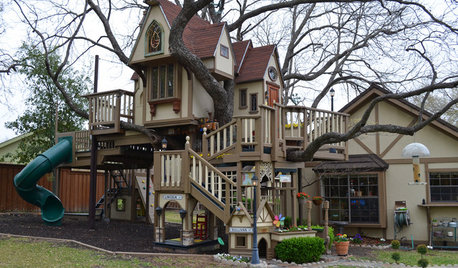What is your guess as to C:N of a cottonwood tree leaves and all?
13 years ago
Related Stories

FALL GARDENING5 Ways to Put Fall Leaves to Work in Your Garden
Improve your soil and yard the organic way with a valuable garden booster that grows on trees
Full Story
DECLUTTERINGDownsizing Help: Choosing What Furniture to Leave Behind
What to take, what to buy, how to make your favorite furniture fit ... get some answers from a homeowner who scaled way down
Full Story
GREEN BUILDINGStudents’ Award-Winning Home Leaves Small Footprint
A cost-effective, solar-powered New Zealand prefab home has good looks to match
Full Story
FALL GARDENING11 Trees for Brilliant Fall Color
Give your landscape the quintessential look of autumn with the red, orange and yellow leaves of these standouts
Full Story
GARDENING GUIDESGreat Design Tree: Australian Tea Tree
A living sculpture with an unmistakable appearance, this coastal native creates an intriguing landscape scene
Full Story
TREES7 Deer-Resistant Flowering Trees to Plant this Fall
If you live in a neighborhood with roaming deer, consider these beautiful trees that won't tempt hungry guests
Full Story
MOST POPULARThe Most Incredible Kids' Tree House You'll Ever See?
Duck your head to enter this unforgettable Dallas wonderwork, lovingly crafted with imaginative delights
Full Story
HOUSEKEEPINGHow to Clean Grout — Stains and All
If your grout is grossing you out, this deep-cleaning method will help it look new again
Full Story
KITCHEN DESIGNWhat to Know When Choosing a Range Hood
Find out the types of kitchen range hoods available and the options for customized units
Full Story
ARCHITECTUREAll the Possibilities: 4 Homes at the Edge of the Earth
Travel to the far reaches of land, where these residences straddle rocky cliffs, leafy lakeshores and choppy inlets
Full StoryMore Discussions







ceth_k
Kimmsr
Related Professionals
Piqua Landscape Architects & Landscape Designers · Brookside Landscape Contractors · Boca Raton Landscape Contractors · Brookfield Landscape Contractors · Columbine Landscape Contractors · Long Branch Landscape Contractors · Madera Landscape Contractors · North Chicago Landscape Contractors · Northport Landscape Contractors · Ringwood Landscape Contractors · Riverview Landscape Contractors · White Bear Lake Landscape Contractors · Asheville Decks, Patios & Outdoor Enclosures · Auburn Decks, Patios & Outdoor Enclosures · Lincolnton Decks, Patios & Outdoor Enclosuresrobertz6
Kimmsr
curt_grow
jolj
rott
daguvanuh
gardengal48 (PNW Z8/9)
jolj
bosal44
daguvanuh
Lloyd